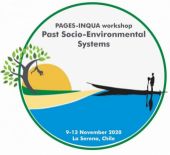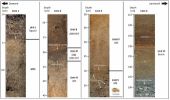The Spotlight #4
Posted by Francesca Ferrario in ECR News on 15 Feb 2022
The Quaternary International paper highlighted today is entitled “Environmental trends during the Bronze Age recorded in paleosols buried under a big kurgan in the steppes of the Ponto-Caspian area”, by Olga Khokhlova, Alena Sverchkova and co-authors. Link to paper.
The research
Kurgans are earthen archaeological monuments constructed over a grave; they are widespread in the Ponto-Caspian area and may present a complex architecture with several constructions. The paleosols under the burial mounds usually present a defined chronological order (soils in the center of the mound are older than those at the periphery) and are an important paleoenvironmental archive.
The authors investigated a 4-m tall Bronze Age kurgan located in the Krasnodar region (Figure 1); three paleosols are studied through a bunch of truly multi-disciplinary techniques, including (micro)morphology, grain size, palynology, organic and carbonate carbon, gypsum content, magnetic susceptibility and even more!

Figure 1: location of the study area, Google Maps imagery.
Four soil profiles (3 paleosols and a surface soil) were studied in order to better understand the soil evolution and climate changes during the period of kurgan constructions (Figure 2). The kurgan itself show three construction phases, two of which are attributed to the Novotitorovo culture dated to the end of the early – beginning of Middle Bronze Age, 27th – 22nd centuries BC. The third structure was constructed by the people of the Catacomb culture, 21st - 16th centuries BC, Middle Bronze Age.
During the first stage the humid climate provided a high bioproductivity, while later on a gradual increase in aridity is recorded.

Figure 2: Sketch of the main characteristics of the studied soil profiles.
Why should we care?
The investigation of paleosols buried beneath kurgans is a tool to unravel the climatic evolution of the study area; an added value is that the presence of several paleosols offers a snapshot at different times in the past. When coupled with archaeological reconstructions, a multi-faceted reconstruction of the environment can be pursued. Investigations at multiple sites will provide a regional picture, useful to understand the environmental trends that the region will undergo in the future.
The Author
Alena Sverchkova is a postgraduate student and junior researcher in the Institute of Physics-Chemical and Biological Problems of the Russian Academy of Sciences. In 2019 I graduated from the Faculty of Geography, Department of Landscape Geochemistry and Soil Geography, in MSU. I have master’s science in Ecology. The topic of my diploma was research of kurgans and buried soils under them, and paleoclimatic reconstruction. During studies, I published research in various Russian and foreign journals, participated in conferences, have various certificates and diplomas for participation in conferences. At the present moment have been published 16 articles in various journals and participated in 14 conferences.
Post written by Francesca Ferrario, Terpro ECR Representative.




